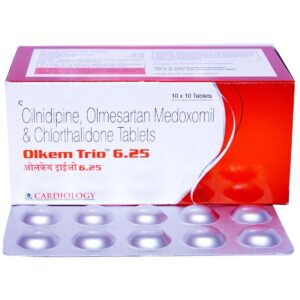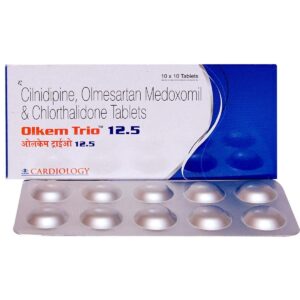CHLORTHALIDONE + OLMESARTAN + CILNIDIPINE
Chlorthalidone: Chlorthalidone is a medication that belongs to the class of drugs known as thiazide diuretics. It is mainly used to treat high blood pressure (hypertension) and reduce fluid retention (edema) in conditions such as congestive heart failure.
The mechanism of action of chlorthalidone involves increasing the excretion of water and sodium from the kidneys, which leads to a decrease in blood volume. This subsequently decreases the workload on the heart and lowers blood pressure. Chlorthalidone primarily acts by inhibiting the reabsorption of sodium and chloride ions in the renal tubules, promoting their elimination in the urine.
The usual starting dose of chlorthalidone for hypertension is 25 mg once daily, which can be increased to 50-100 mg per day if necessary. For edema, the typical daily dose is 50-100 mg. It is important to take this medication as prescribed and follow the instructions given by your healthcare provider.
Some common side effects of chlorthalidone include dizziness, weakness, fatigue, muscle cramps, increased urination, and low blood pressure. Additionally, it may cause electrolyte imbalances, such as low levels of potassium, sodium, and magnesium. This can potentially result in symptoms like muscle weakness, irregular heartbeats, and excessive thirst.
Less common but more serious side effects can occur, such as allergic reactions, severe skin rashes, kidney problems, and blood disorders. If you experience any of these serious side effects, it is important to seek immediate medical attention.
As with any medication, it is advised to discuss with a healthcare professional about the potential benefits and possible side effects of chlorthalidone before starting treatment.
Olmesartan: Olmesartan is a medication used to treat high blood pressure (hypertension). It belongs to a class of drugs known as angiotensin II receptor blockers (ARBs).
The drug works by blocking the action of a hormone called angiotensin II, which causes blood vessels to constrict. By blocking the action of this hormone, Olmesartan helps to relax and widen the blood vessels, thereby lowering blood pressure.
The usual starting dose of Olmesartan for adults is 20 mg once daily. The dose may be increased to a maximum of 40 mg once daily, depending on individual response. It can be taken with or without food.
Some common side effects of Olmesartan may include dizziness, diarrhea, back or joint pain, nausea, headache, and fatigue. It is important to report any persistent or severe side effects to a healthcare professional.
There have been rare reports of a serious condition called sprue-like enteropathy associated with Olmesartan. This condition can cause severe and chronic diarrhea with significant weight loss. If you experience persistent and severe diarrhea while taking Olmesartan, it is important to seek medical attention.
Olmesartan may also have interactions with other medications, so it is important to inform your healthcare provider of all the drugs you are taking, including over-the-counter medications, supplements, and herbal remedies.
It is essential to follow the prescribed dosage and schedule as instructed by a healthcare professional when taking Olmesartan. It is not recommended to stop taking the medication abruptly without consulting a doctor as this may cause a rebound increase in blood pressure.
Overall, Olmesartan is an effective medication used to manage high blood pressure, and it is well-tolerated by most individuals. However, it is important to discuss potential risks and benefits with a healthcare provider before starting this medication.
Cilnidipine: Cilnidipine is a calcium channel blocker drug that is mainly used for the treatment of high blood pressure (hypertension). It is prescribed to help reduce elevated blood pressure and improve blood flow to the heart and other organs.
The mechanism of action of Cilnidipine involves blocking the calcium channels in blood vessels, which relaxes and widens them. This relaxation leads to a decrease in peripheral resistance and a subsequent drop in blood pressure. Additionally, Cilnidipine also acts on the central nervous system to reduce sympathetic nerve activity, further helping to lower blood pressure.
The usual recommended dose of Cilnidipine is 10-20 mg per day, taken orally. The dosage may vary depending on the individual’s condition and response to treatment. It is generally recommended to start with a lower dose and gradually increase as needed, under medical supervision.
Like any medication, Cilnidipine may cause side effects. Common side effects include dizziness, headaches, flushing, edema (swelling), and palpitations. These side effects are usually mild and go away on their own. However, if they persist or become severe, it is important to inform a healthcare professional. In rare cases, Cilnidipine can cause more serious side effects such as irregular heartbeat, chest pain, or allergic reactions. If any of these occur, immediate medical attention is required.
It is important to note that Cilnidipine should not be stopped abruptly without consulting a doctor, as sudden discontinuation can cause rebound hypertension. It is always recommended to follow the prescribed dosage and inform a healthcare professional about any other medications or medical conditions before starting Cilnidipine.


